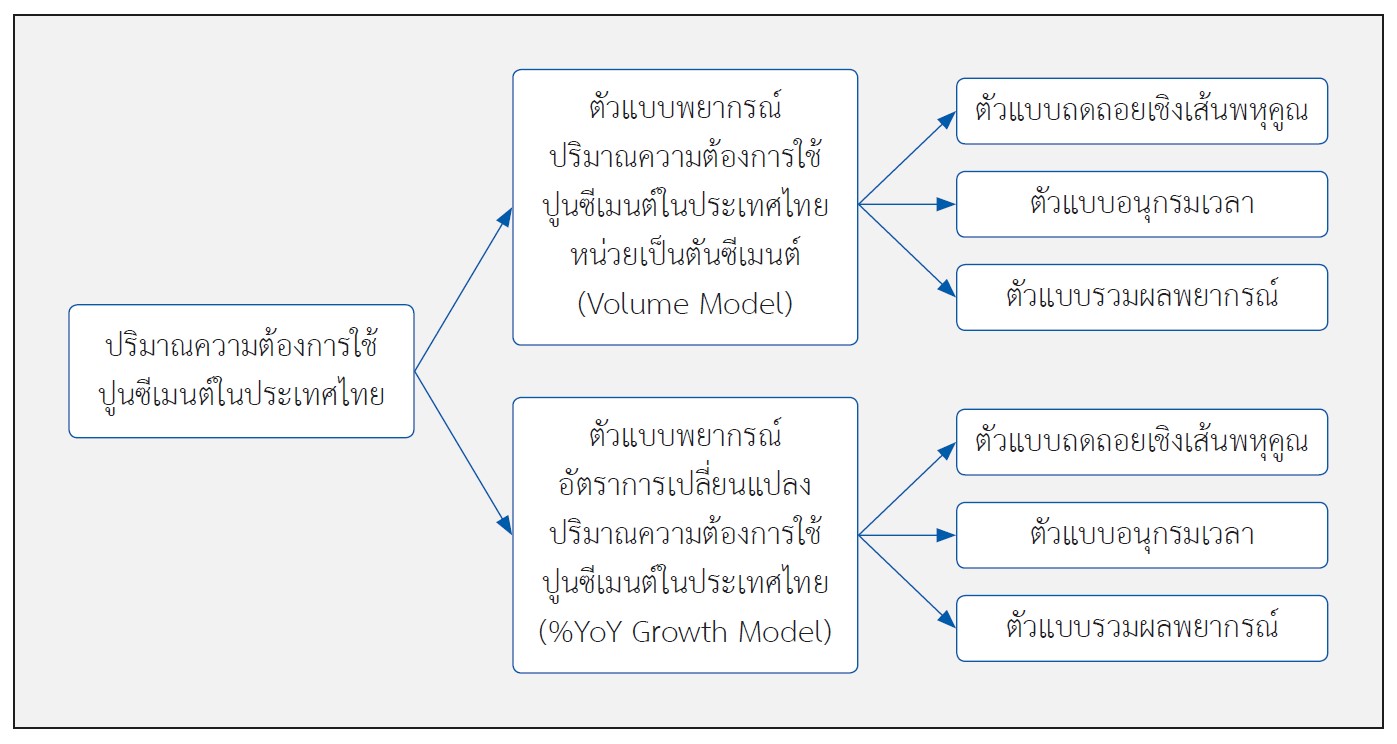การพยากรณ์ความต้องการใช้ปูนซีเมนต์ในประเทศไทย
คำสำคัญ:
การพยากรณ์, ปูนซีเมนต์, ความต้องการใช้, การวิเคราะห์ถดถอย, การรวมผลพยากรณ์บทคัดย่อ
งานวิจัยนี้เป็นงานวิจัยเชิงประยุกต์ (Applied Research) มีวัตถุประสงค์เพื่อศึกษาความสัมพันธ์ระหว่างปัจจัยเศรษฐกิจมหภาคและปัจจัยด้านประชากร กับปริมาณความต้องการใช้ปูนซีเมนต์ในประเทศไทย ทั้งในรูปแบบปริมาณที่มีหน่วยเป็นตันซีเมนต์ และอัตราการเปลี่ยนแปลงปริมาณความต้องการใช้ปูนซีเมนต์เทียบช่วงเดียวกันของปีก่อน สำหรับใช้พยากรณ์ความต้องการใช้ปูนซีเมนต์ในประเทศไทยในระยะ 5 ปีข้างหน้า โดยพัฒนาตัวแบบถดถอยพหุคูณ ตัวแบบอนุกรมเวลาแบบ Simple และ Holt’s Exponential Smoothing ตัวแบบ ARIMA และตัวแบบรวมผลพยากรณ์ เพื่อให้ได้ผลการพยากรณ์ที่มีความผิดพลาดต่ำที่สุด จากการศึกษาพบว่า ตัวแบบรวมผลพยากรณ์ระหว่างตัวแบบถดถอยพหุคูณกับตัวแบบ ARIMA ทั้งในตัวแบบปริมาณความต้องการใช้ปูนซีเมนต์และตัวแบบอัตราการเปลี่ยนแปลงปริมาณความต้องการใช้ปูนซีเมนต์ให้ค่าความคลาดเคลื่อนที่ต่ำที่สุด โดยผลของตัวแบบรวมผลพยากรณ์ทั้งสองแสดงให้เห็นว่าปริมาณความต้องการใช้ปูนซีเมนต์ในประเทศไทยในปี 2021 อยู่ในช่วง 36,223 - 42,082 พันตัน อย่างไรก็ตาม ตัวแบบรวมผลพยากรณ์ปริมาณความต้องการใช้ปูนซีเมนต์ในประเทศ ให้ค่า RMSE ที่ 753 พันตัน น้อยกว่าค่า RMSE ของตัวแบบรวมผลพยากรณ์ของปริมาณความต้องการใช้ปูนซีเมนต์ในประเทศ ซึ่งให้ค่า RMSE ที่ 2,099 พันตัน
References
Box, G. and Jenkins, G. (1970). Time Series Analysis: Forecasting and Control. Holden-Day, San Francisco.
Cao, Z., Shen, L., Liu, L. & Zhong S. (2016). Analysis on major drivers of cement consumption during the urbanization process in China. Journal of Cleaner Production, 133, 304-313.
Chambers, J. C., & Mullick, S. K., Smith, D. D. (July 1971). How to Choose the Right Forecasting Technique. Harvard Business Review.
Chungcharoen, E. (2017). Business Forecasting. Thammasat University Press.
Davidson, E. (June 2014). Defining the Trend: Cement consumption versus Gross Domestic Product. Global Cement Magazine.
Dobrotă, G., & Căruntu, C. (2013). The Analysis of the Correlation between the Economic Growth and Crude Steel Production in the Period 1991-2011. Metalurgija, 425-428.
Holt, C.C. (1957). Forecasting Seasonals and Trends by Exponentially Weighted Moving Averages. ONR Memorandum, 52, Carnegie Institute of Technology, Pittsburgh.
Li, H. (2014). The Effects of Demographics on the Real Estate Market in the United States and China. Honors College Theses. 137.
Li, N., Ma, D., & Chen, W. (2015). Projection of Cement Demand and Analysis of the Impacts of Carbon Tax on Cement Industry in China. Energy Procedia, 75, 1766-1771.
Lim, J., & Lee, J. (2013). Demographic changes and housing demands by scenarios with ASFRs. International Journal of Housing Markets and Analysis, 6(3), 317-340.
Low, S. (1983). The Global Cement Industry, Singapore: Singapore University Press.
Mankiw, N. G., & Weil, D. N. (1989). The Baby Boom, The Baby Bust, and The Housing Market. Regional Science and Urban Economics, 19, 235-258.
Nelson, C.R. (1984). A Benchmark for the Accuracy of Econometric Forecasts of GNP. Business Economics, 19(3), 52-58.
Noppawong, H. (2009). Cement Consumption in Thailand Construction Industry (Dissertation). School of Development Economics, National Institute of Development Administration.
Office of Industrial Economics. (2007). Thailand Cement Industry: Bright Future?
Wei, X. (2009). Regression-Based Forecast Combination Methods. Journal of Economic Forecasting, 4, 5-18
Yang, Y. (2004), Combining Forecasting Procedures: Some Theoretical Results, Econometric Theory, 20, 176-222.

Downloads
เผยแพร่แล้ว
How to Cite
ฉบับ
บท
License
Copyright (c) 2020 https://creativecommons.org/licenses/by-nc-nd/4.0/

This work is licensed under a Creative Commons Attribution-NonCommercial-NoDerivatives 4.0 International License.


